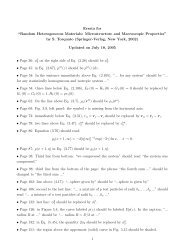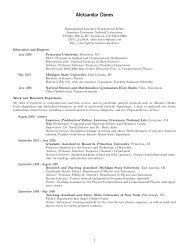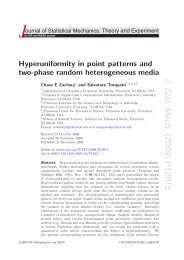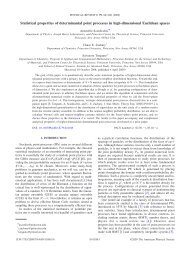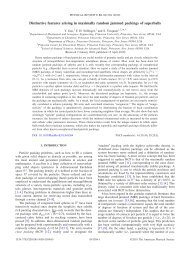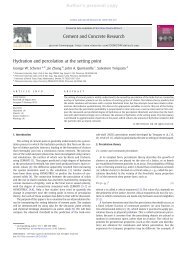Families of tessellations of space by elementary polyhedra via ...
Families of tessellations of space by elementary polyhedra via ...
Families of tessellations of space by elementary polyhedra via ...
You also want an ePaper? Increase the reach of your titles
YUMPU automatically turns print PDFs into web optimized ePapers that Google loves.
RUGGERO GABBRIELLI, YANG JIAO, AND SALVATORE TORQUATO PHYSICAL REVIEW E 86, 041141 (2012)<br />
TABLE II. The four canonical tilings <strong>by</strong> regular tetrahedra and<br />
octahedra, i.e., the tiling associated with the uniform packing <strong>of</strong><br />
tetrahedra (UT), the FCC tiling, the tiling associated with the layered<br />
packing <strong>of</strong> octahedra (LO), and the tiling associated with the conjectured<br />
densest octahedron packing (DO) [25]. Note the relationship<br />
between the side ratio s, tile ratio t, and packing fraction <strong>of</strong> the<br />
octahedra. The <strong>space</strong> group associated with each tiling is also given.<br />
Name s t φo Space group<br />
UT 1/2 1 1/3 P 4/mmm<br />
FCC 1 1/2 2/3 Fm¯3m<br />
LO 2 1/4 8/9 trig.<br />
DO 3 1/6 18/19 R¯3<br />
A. The tiling associated with the uniform packing<br />
<strong>of</strong> tetrahedra (UT tiling)<br />
In Ref. [19], Conway and Torquato constructed a dense<br />
periodic packing <strong>of</strong> regular tetrahedra, whose fundamental<br />
cell contains two tetrahedra forming partial face-to-face contacts.<br />
Specifically, the tetrahedra are arranged on a primitive<br />
tetragonal lattice [19] and oriented in two mutually orthogonal<br />
directions. The vertex coordinates <strong>of</strong> the two tetrahedra in the<br />
fundamental cell are given <strong>by</strong><br />
PT 1 ={0,1/2,0}, {1, − 1/2,0}, {1,1/2,1}, {0, − 1/2,1},<br />
(6)<br />
PT 2 ={−1/2,0,0}, {1/2,1,0}, {1/2,0,1}, {−1/2,1,1}.<br />
And the lattice vectors <strong>of</strong> the uniform packing are given <strong>by</strong><br />
a1 = (1,0,0) T , a2 = (0,1,0) T , a3 = (1/2,1/2,1) T . (7)<br />
The center <strong>of</strong> a contacting region is also the inversion<br />
center associated with the contacting tetrahedron pairs. Every<br />
tetrahedron in the packing can be mapped to another one <strong>by</strong><br />
translation and center-inversion operation. Thus, this packing<br />
is referred to as the “uniform tetrahedron packing.” At the<br />
time <strong>of</strong> this discovery, no mention was made <strong>of</strong> the holes in<br />
this packing.<br />
Interestingly, we find that the holes in the uniform tetrahedron<br />
packing are in fact regular octahedra whose edge length is<br />
half <strong>of</strong> that <strong>of</strong> a tetrahedron. Filling the holes with octahedra <strong>of</strong><br />
proper size leads to a novel tiling <strong>of</strong> R3 <strong>by</strong> tetrahedra and small<br />
octahedra. In the tiling, each tetrahedron has face contacts<br />
with four tetrahedra and eight octahedra, and each octahedron<br />
shares its faces with eight tetrahedra. The fundamental repeat<br />
unit contains two tetrahedra and two small octahedra. A portion<br />
<strong>of</strong> the net <strong>of</strong> the octahedra surrounding each tetrahedron is<br />
shown in Fig. 2. In the full, triply periodic net, each octahedron<br />
shares four <strong>of</strong> its edges with four different neighbors.<br />
TABLE III. The three canonical tilings <strong>by</strong> regular truncated<br />
tetrahedra and regular tetrahedra. Note the relationship between side<br />
ratio s, tile ratio t, and packing fraction <strong>of</strong> the truncated tetrahedra<br />
φtt. The <strong>space</strong> group associated with each tiling is also given.<br />
Name s t φtt Space group<br />
TH 1/3 3 23/32 trig.<br />
crs 1 1 23/24 Fd¯3m<br />
TT 3 1/3 207/208 trig.<br />
041141-4<br />
FIG. 2. The eight octahedra surrounding each tetrahedron in the<br />
UT tiling, which is associated with the uniform packing <strong>of</strong> tetrahedra.<br />
Each octahedron shares four <strong>of</strong> its edges with four <strong>of</strong> its neighbors.<br />
B. The FCC and related tilings<br />
Consider an octahedron PO defined <strong>by</strong> the relation<br />
PO ={x ∈ R 3 : |x1|+|x2|+|x3| 1}, (8)<br />
which is placed on the lattice sites specified <strong>by</strong><br />
a1 = (1,1,0) T , a2 = (−1,1,0) T , a3 = (0,1,1) T . (9)<br />
In this octahedron packing (with a density φ = 2/3), four<br />
octahedra, with each making contacts <strong>by</strong> sharing edges perfectly<br />
with the other three, form a regular-tetrahedron-shaped<br />
hole with the same edge length as the octahedra. If tetrahedra<br />
<strong>of</strong> proper size are inserted into the holes <strong>of</strong> the packing, then the<br />
FCC tetrahedron-octahedron tiling is recovered (see Fig. 6). In<br />
this periodic tiling, each octahedron makes perfect face-to-face<br />
contacts with eight tetrahedra. The fundamental repeat unit<br />
<strong>of</strong> this tiling contains one octahedron and two congruent<br />
tetrahedra. Individual layers <strong>of</strong> this tiling completely fill the<br />
<strong>space</strong> between two parallel planes at a distance equal to the<br />
diameter <strong>of</strong> an inscribed sphere in an octahedron (the distance<br />
between two opposite faces <strong>of</strong> an octahedron). This property<br />
allows the generation <strong>of</strong> an infinite family <strong>of</strong> tilings based on<br />
stackings <strong>of</strong> layers <strong>of</strong> the type described above, all having the<br />
same side ratio, but that cannot be retessellated into the FCC<br />
tiling. One well-known example is hexagonal close packed<br />
(HCP) structure, but it is also possible to generate nonperiodic<br />
arrangements.<br />
C. The tiling associated with the layered packing<br />
<strong>of</strong> octahedra (LO tiling)<br />
Here, we derive a heret<strong>of</strong>ore undiscovered canonical tiling<br />
<strong>of</strong> R3 <strong>by</strong> congruent octahedra and small congruent tetrahedra,<br />
which has not been presented before in the literature to the best<br />
<strong>of</strong> our knowledge. Consider an octahedron defined <strong>by</strong> Eq. (8)<br />
that is placed at each lattice site specified <strong>by</strong> the lattice vectors<br />
a1, a2, and a3:<br />
a1 = − 1<br />
2<br />
,1, 1<br />
2<br />
T , a2 = (−1,1,0) T , a3 = − 1 1<br />
, 2 2 ,1 T<br />
.<br />
(10)<br />
This lattice packing has a density <strong>of</strong> φ = 8/9, in which each<br />
octahedron makes face contact with eight neighbors, leading<br />
to small tetrahedral holes. The edge length <strong>of</strong> the tetrahedral



